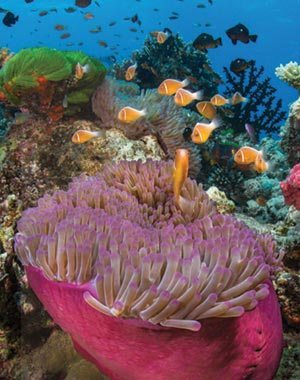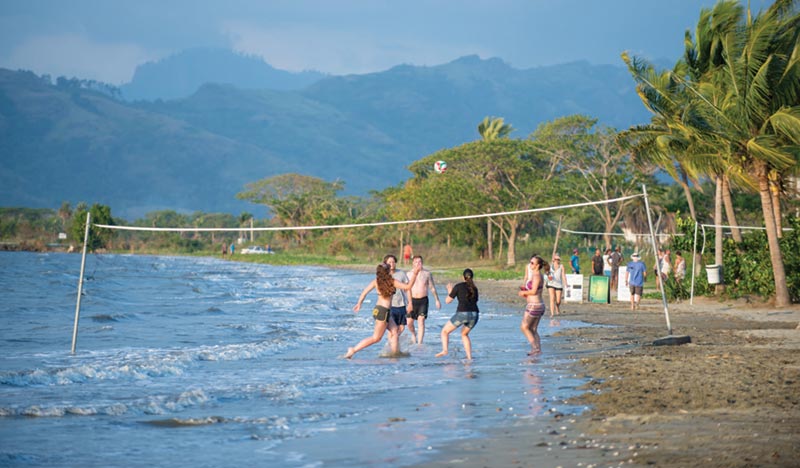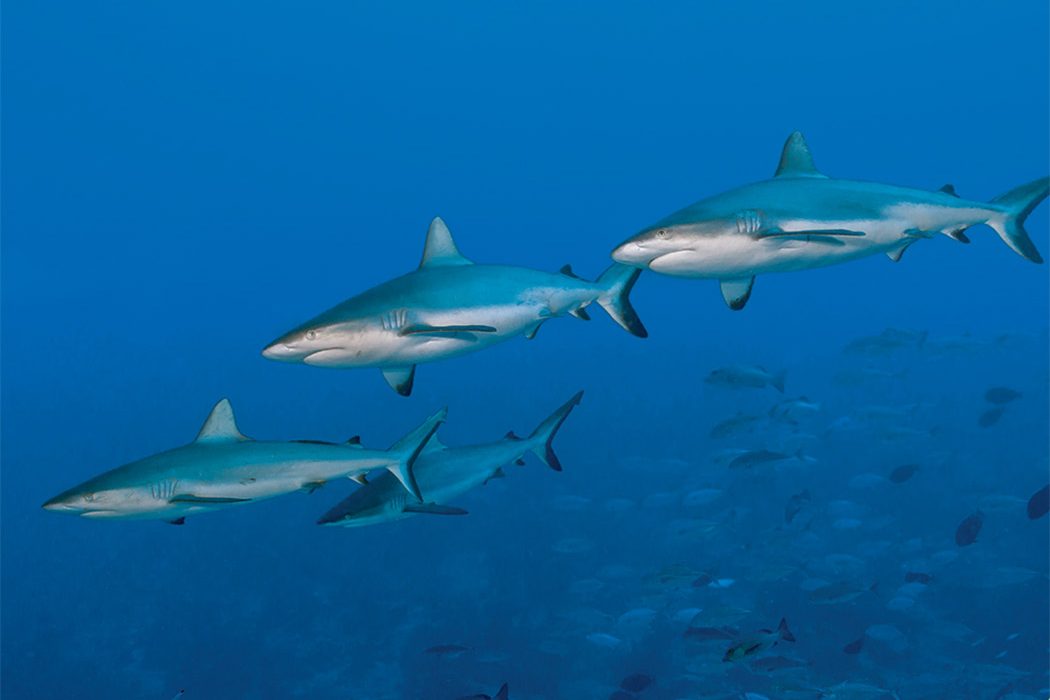Located in the heart of the South Pacific, Fiji is blessed with 333 tropical islands. Fiji’s white-sand beaches and pristine ocean waters offer an ideal vacation destination for divers, honeymooners and families but perhaps Fiji’s greatest appeal comes from its people.
According to a 2014 WIN/Gallup International poll of countries, Fiji’s people are the happiest on Earth, and this is obvious from the moment one steps off the plane. I can’t help but smile when the plane door opens and a warm tropical breeze greets me, for I know that, from this point on, I will be greeted by warm, friendly smiles as well. Arriving in Fiji is the most welcomed I’ve ever felt entering a country. Everyone is genuinely happy as they extend their greetings; even the band members in the immigration area, singing Fijian welcoming songs, appear to be full of joy in their work.
“Bula” is the traditional Fijian greeting. Much like the Hawaiian “aloha,” bula has a variety of meanings, each of which depends on the situation. Pronounced boolah, it literally means “life.” When used as a greeting, it is to express wishes for good health. The full saying is “Ni sa bula vinaka,” pronounced nee-sahmbula-veenak-ah, meaning, “Wishing you happiness and good health.”
Fiji’s physical remoteness offered protection from European mariners well into the 19th century. As a result, Fijians have retained their land and the noncommercial, sharing attitude that comes from people with direct access to natural resources. Modern life in Fiji stills centers on an extended family unit and a chieftain with 87 percent of the country’s land owned by the community and administered by a land trust. Children are revered and are well-cared for by the community. These are among the reasons Fijians are so friendly and welcoming to visitors.
It Wasn’t Always Like That

Photo by Chris Huss.
Fijian culture is a mix of influences from Polynesian, Melanesian and Micronesian peoples who came to the islands over the years.
The original inhabitants of Fiji, the Lapita people, called their home Viti. The Lapita people probably came from Vanuatu and arrived about 1220 B.C. It appears they were only there a short while before disappearing from the archaeological record. Their descendants, who became assimilated with people who arrived from Melanesia, were mostly coastal dwellers that relied on fishing and lived in relative peace. Around 500 B.C. a shift toward agriculture occurred and that, along with an expansion of the population, led to an increase in intertribal feuding as well as cannibalism.
Cannibalism was first started by Fijians during their long voyages at sea. The lack of adequate nutrition forced these sailors to consume the dead in order to survive and this practice remained a part of the Fijian diet even once back on land. There was a gradual increase of human population on the islands, which led to the competition for natural resources, property and women, and probably helped to keep the tradition of cannibalism ongoing.
The first European to sail past the Fiji islands was Abel Tasman in 1643, and his descriptions of treacherous reef systems kept mariners away for years. European whalers and traders eventually overcame their fears of the reefs and cannibalism and began to visit. Missionaries started to arrive in the 1830s to convert the population to Christianity and preach against cannibalism. Christianity was slowly accepted because there were similarities to the Fijian’s existing beliefs of tabu (sacred prohibitions) and mana (spiritual power). Many villagers continue to worship their ancestral gods through such practices as the kava ceremony, and observing tabu areas and codes of conduct.
British Rule
“Blackbirding” is a term used to describe the trade in cotton laborers that came about by the worldwide cotton shortage prompted by the American Civil War. Europeans brought over other Pacific Islanders to labor in the Fijian cotton fields.
Initially, these people were coaxed into agreeing to work for three years in return for minimal wages, food, clothing and return passage. Later, chiefs were bribed and these men and women were not allowed to return home. By the 1870s this practice had developed into an organized system of kidnapping, and stories of atrocities and abuses by recruiters resulted in pressure on Britain to stop the trade. Fiji was pronounced a British crown colony in 1874 citing the need to abolish blackbirding as justification.
To maintain good relations with its subjects, the new colonial government prohibited the employment of indigenous Fijians as plantation laborers. Plantation crops such as cotton, copra and sugar cane had the potential to make the Fiji economy self-sufficient, but demanded large pools of cheap labor. So, in 1878 negotiations were made with the Indian colonial government for laborers to come to Fiji on five-year contracts, after which time the laborers were free to return to India, under certain conditions. It was a difficult life but, despite the hardship, the vast majority of Indians decided to stay in Fiji once they had served their contract and many brought their families to join them. Today, the descendants of the Indian indentured laborers, known as Indo-Fijians, make up almost 40 percent of the population of Fiji. Indigenous Fijian people account for more than 50 percent of the population, with the remainder of the population being a mix of Europeans, Chinese and Pacific Islander with origins outside of Fiji.
Fiji became independent from British rule in 1970 and has since become one of the most developed economies in the Pacific due to an abundance of forest, mineral and fish resources. Today, Fiji’s main source of income is its tourist industry followed by the sugar industry.
A Volcanic Start
The Fijian islands were formed through volcanic activity starting around 150 million years ago. Even today, some say there is still some geothermal activity that occurs on the islands of Vanua Levu and Taveuni. Taveuni, in fact, is known as the “Garden Island” because of its rich volcanic soils. Fortunately, it only experiences an eruption every 60-65 years.
Today, Fiji is an archipelago of more than 332 islands, with 110 permanently inhabited, and more than 500 islets. The two major islands, Viti Levu and Vanua Levu, account for 87 percent of the population. Viti Levu is the largest island, comparable in size to the Big Island of Hawaii, and has the capital and largest city, Suva. About three-quarters of Fijians live on Viti Levu’s coasts, either in Suva or in smaller urban centers like Nadi (pronounced Nahn-di) or Lautoka, the center of the sugar cane industry. Viti Levu’s interior is sparsely inhabited due to its terrain.
Fiji: Divers Paradise
Fiji offers some of the world’s best scuba diving, with a comprehensive range of excellent dive locations and amazingly diverse marine life that includes large pelagic species such as sharks and tuna, turtles and fish of all hues and sizes.

Fiji is known for its spectacular soft corals. Photo by Chris Huss
Fiji is perhaps best known as being called the “soft coral capital of the world” by Jean-Michel Cousteau. It has an impressive abundance and color combinations of many species of soft coral prevalent in certain areas. Most famous of these areas is Taveuni Island’s Rainbow Reef, which is fed by the nutrient-rich waters that flow through the Somosomo Strait.
Taveuni is also known for “The Great White Wall,” a unique dive site featuring an almost vertical wall that is blanketed in white coral, starting around 80 feet (24 m) and dropping far beyond recreational depth limits. This is a most impressive site even for the well-seasoned diver. At 80 feet, arriving to the brightness of the wall can be almost disorienting. There is so much beauty to take in that is it easy to lose track of your depth. As a photographer, I found it a challenge to find a central point of interest on which to compose a photo; there was just so much going on.
Other dives with impressive soft corals include sites in the area known as Bligh Waters. Named after the famous Captain Bligh of the Bounty who passed through the area in 1789, the Bligh Waters are a stretch of sea that separates Fiji’s main islands of Vanua Levu and Viti Levu. A huge volume of water moves through the deep channel between these islands supplying nutrients to support a thriving ecosystem.
Mellow Yellow, Coral Corner and Rainbow Wall are among my favorite for soft coral photography in Bligh waters. Mellow Yellow, as the name implies, has a high concentration of yellow soft corals, which are often surrounded by small purple anthias fish. In the right light, the color combination can be stunning.
The Bligh waters, as with most of the other areas in Fiji, offer much more than just gorgeous soft corals. Grand Central Station and Schoolhouse are two sites that, with the right conditions, can bring in some impressive big animals. The idea with both sites is to swim along the edge of a drop-off and make occasional forays out into the blue to see what might be swimming by. Schools of bigeye trevally, scad and barracuda are common as well as gray reef sharks and, when lucky, mantas and hammerhead sharks will cruise past.
Nigali Passage is another site whose draw is anything but soft coral. The passage is a narrow cut in the surrounding barrier reef that, on an incoming tide, concentrates pelagics from miles around, including up to 20 or more female gray reef sharks. The channel also concentrates a huge school of trevally, three age-segregated schools of barracuda, about a dozen big flowery cod and a school of snappers. The dive is done as a drift starting outside the passage with minimal current and picks up speed until you reach an area called “the bleachers” where a cut in the reef wall makes for a good spot to settle down out of the current and watch the shark show.
Nigali Passage is probably one of the world’s top all-natural shark dives and, if it’s sharks you are after, Fiji also has one of the world’s top shark attraction dives available in Beqa Lagoon. Depending on the time of year, it is possible to see up to eight species of shark: blacktip, whitetip reef, grey reef, silvertip, tawney nurse, sicklefin lemon, bull and even an occasional tiger shark. The originators of the Bega Lagoon shark dive have worked with the Fiji government to designate the area as a protected marine park, the “Shark Reef Marine Reserve.” This conservation project is one of the truly great environmental success stories for creating sustainable and efficient eco-tourism.
One aspect to the diving in Fiji that I particularly enjoy is that almost every site offers some degree of multilevel diving. As a photographer, I appreciate being able to take photos all the way through my safety stop. Some of my more memorable dives were on bommies that started about 60-70 feet (18-21 m) deep and went to within 15 feet (4.5 m) of the surface. The tops of the bommies were so full of life that it was like diving in an aquarium and, when hit by the late afternoon sun, just mesmerizing.
There are countless options for dive operators in Fiji ranging from small island resorts offering local shore dives to luxury live-aboards that cover vast areas. It would be difficult to experience all that Fiji has to offer in a single trip.

No visit to Fiji is complete without experiencing local culture, including dancing, singing and a traditional kava ceremony. Photo by Chris Huss.
Surface Interval in Fiji
Fiji is far from being just about diving; it offers just about anything you can think of, from relaxing on world-class beaches to high-adventure whitewater rafting. On the luxury side there are resorts with pampering spas or you could spend the day at a championship golf course. Fishermen can charter a boat and try their luck catching a variety of game fish. There are hiking and bird watching opportunities, especially on Taveuni. For urban wildlife, Suva has a surprisingly lively nightlife scene. If you want to get back to the water, you can go sea kayaking or take a day cruise to see dozens of beautiful little white sand islands with names like “Castaway” and “Treasure Island.” Or play volleyball on the beach. And, don’t forget to watch a traditional fire dance at some point during your visit.
If you are looking for souvenirs to bring home, be sure to allot half a day to check out all the shops in Nadi and, while you are in the area, grab a taxi to Raymond Burr’s orchid park, “Garden of the Sleeping Giant.”
One of my favorite things to do is a hike at Sigatoka Sand Dunes National Park, which is just outside Sigatoka town on Viti Levu. There are two trail options. One takes about an hour and the other two hours. The dunes are impressive in size and fun to try to climb. Be sure to wear adequate footwear because the sand can get very hot. The longer trail, which takes you to a secluded and rugged beach, is well worth the extra time. Be sure to carry plenty of water. If you forget to bring your own, bottled water can be purchased at the park.

Surface intervals can be spent enjoying Fiji’s beautiful beaches. Photo by Chris Huss.
Another place worth visiting is the Kula Eco Park, also near Sigatoka so it could be combined with a trip to the dunes. The Eco Park is a 28-acre (11-hectare) property set in three valleys, with 12 acres (4.8 ha) open to visitors. Walk-through enclosures put you inside the habitats of their resident parrots, doves, water birds and reptiles. Marine displays of turtles, soft coral and tropical fish provide a glimpse of the spectacular marine world that surrounds the 300-plus islands of Fiji. It’s a great place to start your trip and get introduced to Fiji’s indigenous species.
Village visits are a good way to experience Fiji culture firsthand, see traditional dancing and experience the kava ceremony. Kava is an earthy-tasting drink made from the root of the pepper plant that is known to make people feel relaxed. It is an important aspect of visiting any village. To partake in the ceremony, you must be offered a bowl of kava. To receive the bowl, you clap once with a cupped hand to make a hollow sound and say “bula!” Drink the whole bowl, then clap three times and say Mathe (mah-tay). You will undoubtedly be offered additional bowls but will not be under obligation to accept them. The Fijians understand kava is not enjoyed by everyone and will appreciate that you gave it a try.
Story and photos by Chris Huss
Official Fiji Tourism Bureau Website
Dive Operators
fiji.travel/us/information/guides/diving
Live-aboards
Fiji Aggressor, aggressor.com
Naia, naia.com.fj
Siren Fleet, sirenfleet.com/liveaboards/fiji.html
Resorts Offering Diving
This is a partial list of major dive resorts. For more info visit fiji.travel.
Beqa Lagoon Resort, beqalagoonresort.com
Garden Island Resort, gardenislandresort.com
Matava Resort, matava.com
Paradise Taveuni, paradiseinfiji.com
Sau Bay Fiji Retreat, saubayfiji.com
Taveuni Dive Resort, taveunidiveresort.com
Ultimate Fiji Vacations, ultimatefijivacations.com
Volivoli Beach Resort, volivoli.com
Waidroka Bay Resort, waidroka.com
Wananavu Beach Resort, wananavu.com






